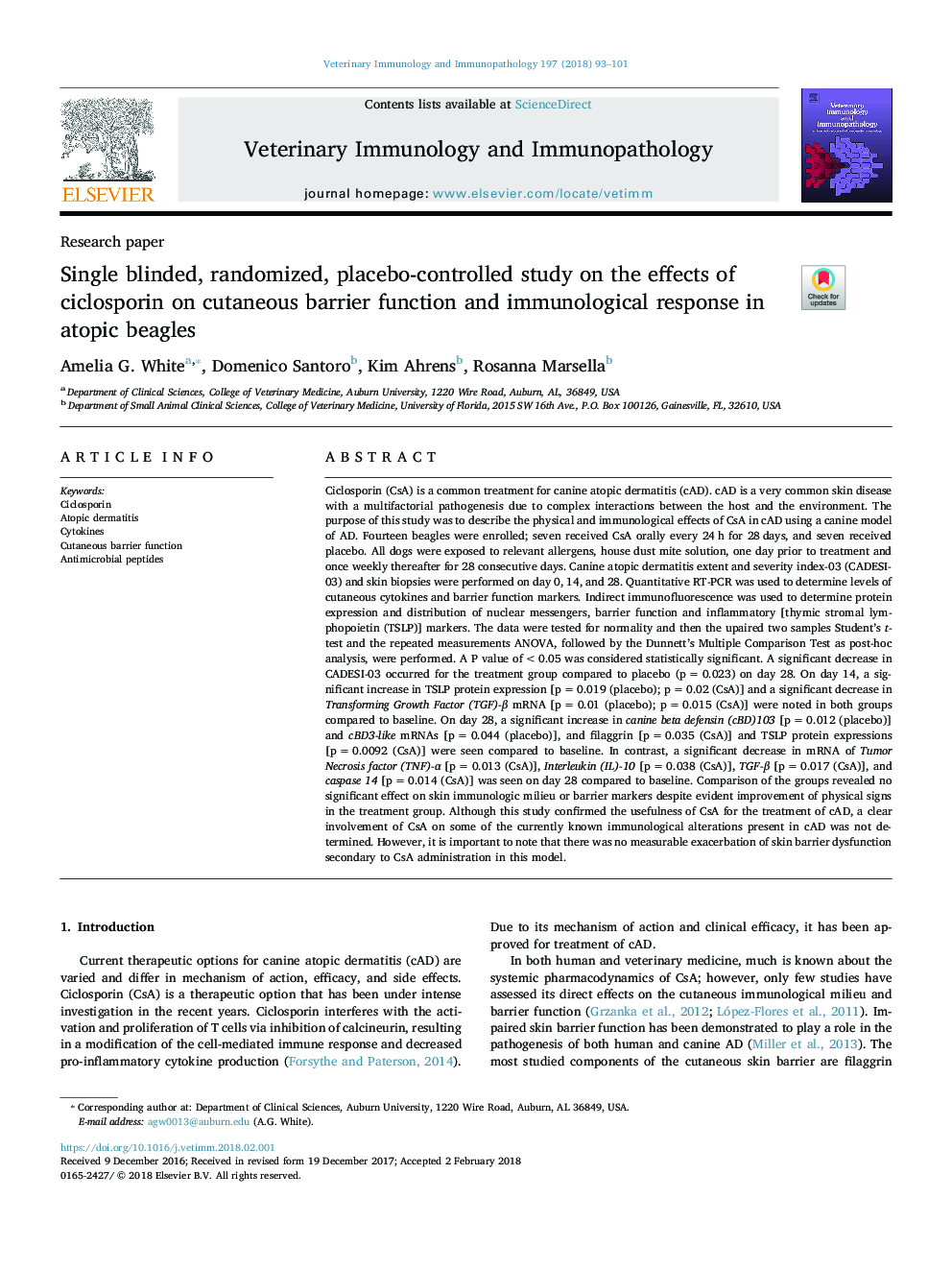| کد مقاله | کد نشریه | سال انتشار | مقاله انگلیسی | نسخه تمام متن |
|---|---|---|---|---|
| 8504757 | 1554988 | 2018 | 9 صفحه PDF | دانلود رایگان |
عنوان انگلیسی مقاله ISI
Single blinded, randomized, placebo-controlled study on the effects of ciclosporin on cutaneous barrier function and immunological response in atopic beagles
ترجمه فارسی عنوان
یک مطالعه کورپور، تصادفی، کنترل شده با پلاسبو بر روی اثرات سیکلوسپورین بر عملکرد عصبی و پاسخ ایمنی در مبتلایان به آتوپیک
دانلود مقاله + سفارش ترجمه
دانلود مقاله ISI انگلیسی
رایگان برای ایرانیان
کلمات کلیدی
سیکلوسپورین، درماتیت آتوپیک، سیتوکین ها، عملکرد مانع پوستی، پپتیدهای ضد میکروبی،
موضوعات مرتبط
علوم زیستی و بیوفناوری
علوم کشاورزی و بیولوژیک
علوم دامی و جانورشناسی
چکیده انگلیسی
Ciclosporin (CsA) is a common treatment for canine atopic dermatitis (cAD). cAD is a very common skin disease with a multifactorial pathogenesis due to complex interactions between the host and the environment. The purpose of this study was to describe the physical and immunological effects of CsA in cAD using a canine model of AD. Fourteen beagles were enrolled; seven received CsA orally every 24â¯h for 28â¯days, and seven received placebo. All dogs were exposed to relevant allergens, house dust mite solution, one day prior to treatment and once weekly thereafter for 28 consecutive days. Canine atopic dermatitis extent and severity index-03 (CADESI-03) and skin biopsies were performed on day 0, 14, and 28. Quantitative RT-PCR was used to determine levels of cutaneous cytokines and barrier function markers. Indirect immunofluorescence was used to determine protein expression and distribution of nuclear messengers, barrier function and inflammatory [thymic stromal lymphopoietin (TSLP)] markers. The data were tested for normality and then the upaired two samples Student's t-test and the repeated measurements ANOVA, followed by the Dunnett's Multiple Comparison Test as post-hoc analysis, were performed. A P value of <0.05 was considered statistically significant. A significant decrease in CADESI-03 occurred for the treatment group compared to placebo (pâ¯=â¯0.023) on day 28. On day 14, a significant increase in TSLP protein expression [pâ¯=â¯0.019 (placebo); pâ¯=â¯0.02 (CsA)] and a significant decrease in Transforming Growth Factor (TGF)-β mRNA [pâ¯=â¯0.01 (placebo); pâ¯=â¯0.015 (CsA)] were noted in both groups compared to baseline. On day 28, a significant increase in canine beta defensin (cBD)103 [pâ¯=â¯0.012 (placebo)] and cBD3-like mRNAs [pâ¯=â¯0.044 (placebo)], and filaggrin [pâ¯=â¯0.035 (CsA)] and TSLP protein expressions [pâ¯=â¯0.0092 (CsA)] were seen compared to baseline. In contrast, a significant decrease in mRNA of Tumor Necrosis factor (TNF)-α [pâ¯=â¯0.013 (CsA)], Interleukin (IL)-10 [pâ¯=â¯0.038 (CsA)], TGF-β [pâ¯=â¯0.017 (CsA)], and caspase 14 [pâ¯=â¯0.014 (CsA)] was seen on day 28 compared to baseline. Comparison of the groups revealed no significant effect on skin immunologic milieu or barrier markers despite evident improvement of physical signs in the treatment group. Although this study confirmed the usefulness of CsA for the treatment of cAD, a clear involvement of CsA on some of the currently known immunological alterations present in cAD was not determined. However, it is important to note that there was no measurable exacerbation of skin barrier dysfunction secondary to CsA administration in this model.
ناشر
Database: Elsevier - ScienceDirect (ساینس دایرکت)
Journal: Veterinary Immunology and Immunopathology - Volume 197, March 2018, Pages 93-101
Journal: Veterinary Immunology and Immunopathology - Volume 197, March 2018, Pages 93-101
نویسندگان
Amelia G. White, Domenico Santoro, Kim Ahrens, Rosanna Marsella,
